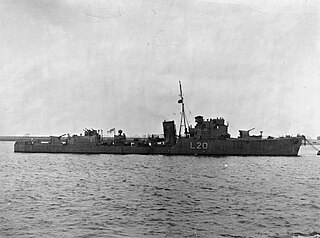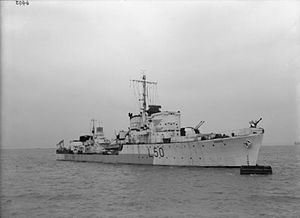
HMS Mendip (L60) was a Hunt-class destroyer of the Royal Navy. She was a member of the first subgroup of the class. The ship is notable for seeing service in the navies of three other nations after her use by the Royal Navy. She saw service in the Second World War and later as an Egyptian Navy ship in the Suez Crisis. She was captured in battle on 31 October 1956 by the Israeli Navy and re-commissioned as INS Haifa (K-38).

HMS Calpe was a British Royal Navy Type II Hunt-class destroyer escort. Built as a result of the outbreak of World War II, Calpe escorted convoys during the war and participated in the Dieppe Raid. Calpe is an old name for Gibraltar. Collaborating with USS Wainwright on 13 December 1943, she assisted in the sinking of German U-boat U-593. Calpe was loaned and then sold to the Danish Navy, remaining active until she was scrapped in Sweden in 1966.

HMS Wheatland was a Type 2 Hunt-class destroyer of the Royal Navy that served in the Second World War.

HMS Vesper was a V-class destroyer of the British Royal Navy that saw service in World War I and World War II.

HMS Vivacious (D36) was a V-class destroyer of the British Royal Navy that saw service in World War I and World War II.

The second HMS Vanity was a V-class destroyer of the British Royal Navy that saw service in World War I and World War II.

The eighth HMS Worcester, was a Modified W-class destroyer of the British Royal Navy that saw service in World War II. She later served as an accommodation ship as the second HMS Yeoman.

HMS Eglinton (L87) was a Type I Hunt-class destroyer of the Royal Navy built by Vickers-Armstrongs on the River Tyne, and launched on 28 December 1939. She was adopted by the town of Alton, Hampshire, as part of the Warship Week campaign in 1942.

HMS Garth was a Type I Hunt-class destroyer of the Royal Navy built by John Brown & Company on the River Clyde, and launched on 28 December 1939. She was adopted by the Civil Community of Wokingham, Berkshire, as part of the Warship Week campaign in 1942.

HMS Cotswold was a Type I Hunt-class destroyer of the Royal Navy which served in World War II. She was scrapped in 1957.

HMS Pytchley was a Type I Hunt-class destroyer of the Royal Navy which served in World War II. She was scrapped in 1956.

HMS Southdown was a Type I Hunt-class destroyer of the Royal Navy which served in World War II. She was scrapped in 1956.

HMS Cowdray was a Type II Hunt-class destroyer of the Royal Navy which served in World War II. She has been the only Royal Navy ship to bear the name. She was scrapped in 1959.

HMS Farndale was a Type 2 Hunt-class destroyer of the Royal Navy which served in World War II. She was scrapped in 1962. She has been the only British Warship so far to bear this name.

HMS Wilton was a Type 2 Hunt-class destroyer of the Royal Navy that served in the Second World War.

HMS Lauderdale was a Hunt-class destroyer of the Royal Navy. Ships of this class were designed as cheap, easily built vessels for convoy escort and antisubmarine duties. She was named like her sisters after a fox hunt, in her case one in Berwickshire. War bonds were issued to finance the building of warships. During Warship Week held in 1942 the civil community of Berwickshire adopted the ship. She has been the only Royal Navy warship to carry this name.

HMS Belvoir was a Hunt-class destroyer of the Royal Navy. She was a member of the third subgroup of the class, and saw service in the Second World War. She was adopted by the civil community of Sutton in Ashfield, Nottinghamshire during Warship Week in 1942.

HMS Melbreak was a Hunt-class destroyer of the Royal Navy. She was a member of the third subgroup of the class, and saw service in the Second World War. All the ships of this class were named after British fox hunts. She was the first Royal Navy warship with this name, after the Melbreak hunt in Cumbria. In 1942 she was adopted by the civil community of Cockermouth in Cumberland, as part of Warship Week.

HMS Haydon was a Hunt-class destroyer of the Royal Navy. She was a member of the third subgroup of the class, and saw service in the Second World War. Most of the ships of this class were named after British fox hunts. She was the first Royal Navy warship to bear this name, after the Haydon hunt in Northumberland. In 1942 she was adopted by the civil community of Wallsend in Northumberland, as part of Warship Week.
HMS Fernie was a Type I Hunt-class destroyer built for the Royal Navy completed in mid-1940. She was adopted by the Civil Community of Market Harborough, Leicestershire, as part of the Warship Week campaign in 1942. She has been the only ship in the Royal Navy to carry this name.



















